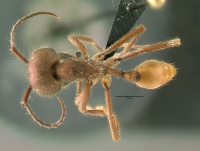Eciton dulcium crassinode
| Eciton dulcium crassinode | |
|---|---|

| |
| Scientific classification | |
| Kingdom: | Animalia |
| Phylum: | Arthropoda |
| Class: | Insecta |
| Order: | Hymenoptera |
| Family: | Formicidae |
| Subfamily: | Dorylinae |
| Genus: | Eciton |
| Species: | E. dulcium |
| Subspecies: | E. dulcium crassinode |
| Trinomial name | |
| Eciton dulcium crassinode Borgmeier, 1955 | |
Identification
Minor worker: head and mesosoma dark red brown, metasoma contrasting orange brown; occipital tooth absent; petiolar teeth long, tapered, and sharp, not in the form of flanges; petiole with anterodorsal elevated flange; fourth abdominal tergite with abundant long pubescence beneath erect setae.
Major worker: face densely micropunctate, matte; long sickle-shaped mandibles simple, without tooth on inner margin; petiole lacking anterodorsal flange; other characters as in minor.
Distribution
Latitudinal Distribution Pattern
Latitudinal Range: 10.42276° to 9.266667°.
| North Temperate |
North Subtropical |
Tropical | South Subtropical |
South Temperate |
- Source: AntMaps
Distribution based on Regional Taxon Lists
Neotropical Region: Costa Rica, Panama (type locality).
Distribution based on AntMaps
Distribution based on AntWeb specimens
Check data from AntWeb
Countries Occupied
| Number of countries occupied by this species based on AntWiki Regional Taxon Lists. In general, fewer countries occupied indicates a narrower range, while more countries indicates a more widespread species. |

|
Estimated Abundance
| Relative abundance based on number of AntMaps records per species (this species within the purple bar). Fewer records (to the left) indicates a less abundant/encountered species while more records (to the right) indicates more abundant/encountered species. |

|
Biology
Jack Longino: This appears to be one of the less common species of Eciton in Costa Rica. I know it from a couple of collections from the Osa Peninsula, and more recently a collection from La Selva Biological Station. This latter observation was a lesson in humility. With 15 years of ant survey work at La Selva, including multiple student projects in which teams of undergraduates searched the La Selva trails for army ants (including nocturnal surveys) I was sure there were only five species of Eciton at La Selva and E. d. crassinode did not occur there. Mike Kaspari emailed me a query, with images of specimens a student of his had collected at La Selva in 2003, and they looked like crassinode. I was surprised and wondered if it was possibly a labelling error. I had my doubts about Mike's record until a visit to La Selva in April 2006, when a nocturnal walk yielded a column of crassinode! Mike actually had two records from 2003, one at LOC1410 at 1043hrs, and one at LOC850 at 1700hrs. My record was at CES450 at 2100hrs.
Association with Other Organisms
 Explore: Show all Associate data or Search these data. See also a list of all data tables or learn how data is managed.
Explore: Show all Associate data or Search these data. See also a list of all data tables or learn how data is managed.
- This species is a associate (details unknown) for the phorid fly Ecitophora bruchi (a associate (details unknown)) (Quevillon, 2018).
- This species is a associate (details unknown) for the phorid fly Ecitophora collegiana (a associate (details unknown)) (Quevillon, 2018).
- This species is a associate (details unknown) for the phorid fly Ecitophora pilosula (a associate (details unknown)) (Quevillon, 2018).
- This species is a associate (details unknown) for the phorid fly Ecitoptera concomitans (a associate (details unknown)) (Quevillon, 2018).
- This species is a associate (details unknown) for the phorid fly Ecitoptera subciliata (a associate (details unknown)) (Quevillon, 2018).
- This species is a associate (details unknown) for the phorid fly Puliciphora borinquenensis (a associate (details unknown)) (Quevillon, 2018).
- This species is a associate (details unknown) for the phorid fly Puliciphora sp. (a associate (details unknown)) (Quevillon, 2018).
- This species is a associate (details unknown) for the phorid fly Thalloptera schwarzmaieri (a associate (details unknown)) (Quevillon, 2018).
- This species is a associate (details unknown) for the phorid fly Thalloptera sp. (a associate (details unknown)) (Quevillon, 2018).
- This species is a prey for the phorid fly Dohrniphora ecitophila (a predator) (Quevillon, 2018).
Castes
- The following images are provided by Harvard University, Museum of Comparative Zoology
Nomenclature
The following information is derived from Barry Bolton's Online Catalogue of the Ants of the World.
- crassinode. Eciton dulcius subsp. crassinode Borgmeier, 1955: 209 (s.q.) PANAMA (Barro Colorado I.).
- Type-material: holotype queen, 2 paratype workers.
- Type-locality: holotype Panama: Canal Zone, Barro Colorado Island, 4.iii.1955 (T.C. Schneirla); paratypes with same data.
- Type-depositories: AMNH (holotype); MZSP (paratypes).
- Subspecies of dulcium: Borgmeier, 1958: 204; Kempf, 1972a: 102; Bolton, 1995b: 184.
- Distribution: Panama.
Description
References
- Borgmeier, T. 1955. Die Wanderameisen der neotropischen Region. Stud. Entomol. 3: 1-720 (page 209, soldier, queen d*Brückner, A., Hoenle, P.O., von Beeren, C. 2018. Comparative chemical analysis of army ant mandibular gland volatiles (Formicidae: Dorylinae). PeerJ 6, e5319 (doi:10.7717/peerj.5319).
escribed)
- Pages using DynamicPageList3 parser function
- Need species key
- Tropical
- Phorid fly Associate
- Host of Ecitophora bruchi
- Host of Ecitophora collegiana
- Host of Ecitophora pilosula
- Host of Ecitoptera concomitans
- Host of Ecitoptera subciliata
- Host of Puliciphora borinquenensis
- Host of Puliciphora sp.
- Host of Thalloptera schwarzmaieri
- Host of Thalloptera sp.
- Host of Dohrniphora ecitophila
- Subspecies
- Extant species
- Formicidae
- Dorylinae
- Eciton
- Eciton dulcium
- Eciton dulcium crassinode
- Dorylinae species
- Eciton species
- Eciton dulcium species
- Need Overview
- Need Body Text








